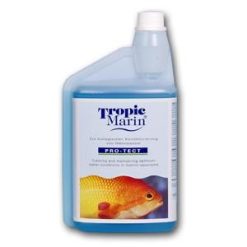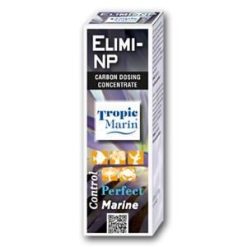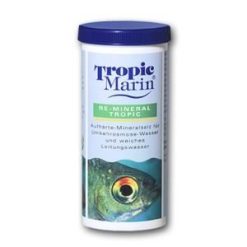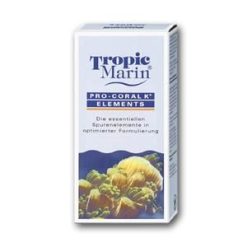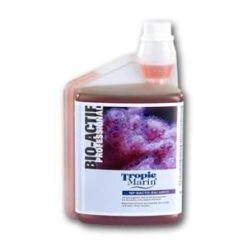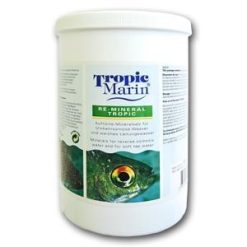HydroPlex™
What is HydroPlex™?
HydroPlex™ is a scientifically developed copper free, antibiotic free, broad spectrum water treatment that is effective for the control of parasites and microscopic organisms found in aquaria and ornamental ponds including bacteria, ciliated protozoa, dinoflagellates, copepods, small [platy]helmenthics and annelids, molds, fungi, yeast and microalgae. HydroPlex™ is also proven to be effective for the elimination of brown slime due to diatoms, as well as for the control of viral diseases. It is especially effective, and strongly, recommended, in a dip regimen for cleansing new arrivals of unwanted parasites and bacteria, especialy if a quarantine tank regimen is not practical. It is very effective for treating diseased fish via a dip regimen or in hospital tanks.
HydroPlex™’s important attributes include:
– Effective Disease Control
– Safety
– Ease of Use
HydroPlex™ contains a unique blend of trade secret anti-microbial formulations available to the hobby industry exclusively through Ruby Reef™.
These formulations (the active ingredients are on the label) are widely used in over-the-counter health care products (e.g., in antibacterial and antifungal products) and in a broad range of cosmetics and beauty aids (e.g., as antimicrobial preservatives). In-other-words, they offer broad-spectrum protection against infectious disease, while being safe for human and animal exposure as well as for disposal down the drain.
The ability to blend these formulations in a single aqueous solution was made possible by the development of a biologically inert stabilizing system. Specifically, the HydroPlex™ stabilizing system allows the component ingredients comprising three formulations to be combined in one solution without any loss (e.g., due to chemical cross-reactions) in the range or effectiveness of any of the three anti-microbial activities. In fact, if stored away from bright light or direct sunlight, HydroPlex™ has a [predicted] shelf life of 5 – 10 years at room temperature.
HydroPlex™ DOES NOT CONTAIN copper, antibiotics, formaldehyde, malachite green or methylene blue.
The development of HydroPlex™ required the collective experience and resources of a three-member product development team. This team included:
– Ruby Reef™;
– An R & D partner that specializes in chemical and biomolecular disease management products for commercial aquaculture, environmental and water resource management, and plant and animal agriculture; and,
–An internationally renowned marine biology research institutionlocated in Woods Hole, MA; the scientists at the Woods Hole institution have made substantial contributions to “calibrating” HydroPlex™ for a variety of applications.
How does HydroPlex™ work?
HydroPlex™ integrates three scientifically proven levels of control. One level aggressively exploits a biochemical vulnerability common to molds, fungi, yeast and microalgae. A second level provides a broad-spectrum shield against infection by microbial organisms. The last level is extremely effective against bacteria, other microbes and small parasites that depend on aerobic respiration for energy.
HydroPlex™ employs a highly penetrative principle that acts — irreversibly — on the biochemical machinery responsible for extracting energy from molecular oxygen. Thus, even small exposures permanently deprive bacteria, ciliated protozoa, dinoflagellates, etc. of the energy required for motility, feeding and reproduction. Due to its excellent penetrative properties HydroPlex™ offers the means for rapid control of microbes and parasites attached to or embedded in gill tissues, attending vasculature and surrounding structures.
What are the applications of HydroPlex™?
– Dips, especially for New Arrivals and Diseased Fish
– Hospital and Quarantine Tanks
– Marine and Tropical Fish
– Koi and Goldfish
– New Ponds* and Aquaria
– Recycling Old Ponds* and Aquaria
* HydroPlex™ is intended for use with ornamental and other closed system ponds that do not discharge into the environment.
Important Notes
DO NOT USE HydroPlex™ with amphibians or cephalopods.
HydroPlex™ is effective for the treatment of Vibrio infections in cephalopods; however, cephalopods may display symptoms of distress and should be closely monitored during treatment.
HydroPlex™ is NOT REEF SAFE and is NOT recommended for use in other established aquariabecause it may compromise biological filtration.
Corals should be closed and polyps should be fully retracted prior to exposure to dip strength HydroPlex™. Some corals display symptoms of distress when exposed (with polyps extended) for long periods (1 – 3 days) to hospital strength HydroPlex.™ Open corals should be closely monitored during treatment.
Instructions for Use of HydroPlex™
CONCENTRATED DIPS: 1.0 Ounce/Quart for 10 Minutes
An effective barrier against the transmission and propagation of parasites borne on new arrivals;
A water treatment strategy that rapidly quenches external infections of bacterial, fungal or other parasitic origin.
When HydroPlex™ is used at either dip or hospital tank strength (see below) it rapidly penetrates the mucous coat and gill tissues of fish. Ciliated and flagellated protozoa thus exposed suffer irreversible effects upon contact. Similarly, when used at dip strength, HydroPlex™ neutralizes most bacteria, fungi, yeast, molds and microalgae within 5 – 10 minutes.
Therefore, HydroPlex™ dips should always be used to control transmission and propagation of parasites and microbes on new arrivals including fish, crustaceans, snails and plants. Dip experiments with corals and other potentially sensitive species are in progress (see Test Results).
General Method:
Aerate and equilibrate fish + packing bag or dip water to the receiving aquarium. Stop aeration and add 1.0 oz HydroPlex™/quart with mixing. Let stand without aeration for 10 minutes and then transfer fish to a recovery tank, or to a hospital/quarantine tank containing 2.0 ozs. HydroPlex™/5 gallons.
Do not exceed the dosage and time frame recommended herein for dips: 10 minutes @ 1.0 oz/quart.
Commercial Packing Bags and Similar Professional Applications:
A more aggressive dip strategy is available for packing and transport bags (e.g., trans-shipments of Indo-Pacific specimens) that bear high densities of fish, high bacterial counts, and/or a high probability of infectious parasites. Add 1.0 oz HydroPlex™/quart as described above. If fish show no undue signs of stress, loss of equilibrium, etc. after 5 minutes, add a second dose of 1.0 oz/quart with mixing. Let stand an additional 5 minutes (10 total minutes) and then transfer fish. However, at a total dose of 2.0 ozs/quart, transfer fish immediately if they display symptoms including loss of equilibrium, extreme clamping of fins or the onset of an unusually inert demeanor. Fish displaying extreme symptoms will typically regain normal vigor and appetite within 24 – 48 hours after transfer to a recovery tank.
Do not dip more than 5 minutes at 2.0 ozs./quart.
HOSPITAL & QUARANTINE TANKS: 2 Ozs./5 Gallons Every 24 Hours.
Elimination of infectious agents in the treatment tank.
We have performed field tests on diseased fish and new arrivals using 2.0 – 4.0 ozs. FreshStart™/5 gallons in hospital and quarantine tanks. Striking results have been observed during experiments with diseased freshwater and marine fish displaying protozoan parasites, infected lesions and ulcers, and a variety of other maladies (see Test Results). Similarly, use of HydroPlex™ in quarantine tanks for new arrivals sharply reduces the incidence of disease, while improving the health, vigor and display quality of fish (e.g., prevents infection and promotes rapid healing of torn or damaged fins).
Our systematic field tests with diseased specimens have focused primarily on freshwater fish including goldfish, Koi, livebearers, cichlids, discus and loachs. One somewhat surprising observation, seen in two experiments with guppies, is that a single exposure to HydroPlex™ at 2.0 oz/5 gallons appears to retard, if not eliminate, wasting disease.
Prolonged exposure to HydroPlex™ at 2.0 ozs/5 gallons has proven completely safe for all fish, plants, crustaceans and snails tested to date, and will therefore constitute the dosage recommended on the label instructions. However, prolonged exposure to 4.0 ozs/5 gallons has proven safe for all crustaceans, snails and plants tested, and most — but not all — fish.
By comparison, 2.0 ozs/5 gallons is dangerously toxic to tadpoles, toads and frogs, and gilled newts and salamanders, and noticeably irritating to squid and octopus.
Due to its extremely efficient and rapid modes of penetration, HydroPlex™ is intended primarily for use in “new water” hospital and quarantine tanks that have not been cycled. However, a “loading dose” regimen has been refined for effective use of HydroPlex™ in cycled or mature aquaria (see below).
The bacteria and other bioload components in a cycled or otherwise mature aquarium will typically absorb all the available HydroPlex™ within 60 minutes at a starting dose of 2.0 ozs/5 gallons. Such exposures are adequate to control all protozoan and microbial parasites accessible during this period (as well as collapse the biologic filter), but no long-term protection (including tissue penetration) is afforded.
“NEW WATER” TANK METHOD: Add 2.0 ozs. HydroPlex™/5 gallons immediately before adding fish.
If necessary, HydroPlex™ can be added at 2.0 ozs/5 gallons every 24 hours thereafter. Do not add more than 4 total doses in any 72 hour period (i.e., @ 0, 24, 48 and 72 hours). Do not aerate for at least 1 hour after the addition of HydroPlex™. Biologic filtration (e.g., a pre-cured over-the-back filter) can be started 24 hours after the last addition of HydroPlex™, or after an adequate carbon filtration step. Due to lack of biologic filtration, water changes may be required. Tanks treated with HydroPlex™ will typically develop a turbid appearance as they begin to cycle.
MATURE AQUARIUM METHOD: Add 2.0 ozs HydroPlex™/5 gallons at 0, 1 and 13 hours, and at 37 and 61 hours as required.
HydroPlex™ SPRAYS: Applied at 10.0 oz/quart (1 part HydroPlex™: 3 parts water)
For recycling contaminated aquaria, ponds & accessories.
HydroPlex™ eliminates the infectious capacity of virtually all microorganisms and small parasites almost upon contact. However, among aquatic organisms tested to date, only snails, crustaceans and fresh water plants can tolerate this level of exposure. Consequently, scientists at both Woods Hole and in our R & D partner’s laboratories have systematically evaluated the use of HydroPlex™ as a concentrated spray. Their goal was to improve the efficiency and economy of recycling fish and animal habitats after exposure to infectious diseases. As a result of these investigations, the following four steps now comprise the standard operating procedure for recycling aquaria, large holding tanks and raceways at the Woods Hole institution after exposure to any infectious disease:
Remove infected livestock and drain the water;
Spray sidewalls, bottom and accessories with concentrated HydroPlex™;
Wait one hour;
Fill with filtered seawater and add new livestock.
This practical application of concentrated HydroPlex™ spray, used in support of rigorous marine biology research, serves as an example that almost requires no additional explanation. Substrates and accessories, as well as sidewalls and bottoms, can be recycled without, for example, implementing the Clorox drill. An additional bonus: no rinsing required.
Use HydroPlex™ sprays to control parasites and microbes including Salmonella in animal habitats.
Routine use of concentrated HydroPlex™ spray on all wet and dry surfaces would constitute an effective tool for the control of Salmonella and other parasites in, for example, turtle and bird habitats.
HydroPlex™ should not be used with any amphibian habitats.
FULL STRENGTH HydroPlex™: For rapid quenching of primary and secondary infections in open wounds, ulcers and sores.
The bioactive formulations in HydroPlex™ are found in a wide range of facial cosmetics and body lotions. They are also found in concentrations up to 1% – 2% in over-the-counter healthcare aids such anti-bacterial soaps, shampoos and oral hygiene products, as well anti-fungal creams and ointments. HydroPlex™ thus affords predictable safety (see Material Safety and Data Sheet in the information packet) for transient contact. Consequently, HydroPlex™ can be applied locally at full strength, with a cotton swab or an eyedropper, to promote the rapid healing of ulcers, sores, wounds and other open lesions displaying signs of bacterial or fungal infections. However, gill tissues should never come in contact with full strength HydroPlex™. The already excellent penetration of HydroPlex™ can be enhanced by mixing it 1:1 with hydrogen peroxide from a local drug store or supermarket immediately prior to application.
Koi & Goldfish
HydroPlex™ promotes the rapid healing and recovery of Koi and goldfish suffering from external parasites, primary and secondary bacterial/fungal infections, and fin and tail rot. One commercial distributor in Massachusetts credits HydroPlex™ with saving the cash value of an especially diseased lot of Koi that did not respond to treatment with formalin, malachite green and/or antibiotics (see Test Results).
Pond maintenance.
Outdoor goldfish and Koi ponds are chronically plagued by algal blooms and fish parasites. However, many parasite problems can be avoided if the parasites are not introduced with new fish. Therefore, immediately prior to adding new goldfish or Koi to a pond, they should be dipped in HydroPlex™ at 1.0 oz/quart of pre-equilibrated water for 10 minutes. At the end of the 10-minute dip period the fish can be transferred to the pond by netting or by pouring.
Outdoor ponds also present special problems in microalg
e and parasite control because contaminants are continually introduced through the air and by other natural vectors. Algal blooms are best dealt with before they occur. Therefore, closed system ponds should be periodically treated with a double dose: add 2.0 ozs/5 gallons, wait 1 hour, add a second 2.0 ozs/5 gallons. This step, which is best used in ponds with an external (i.e., can be isolated) bio-filter, simultaneously provides for control of bacteria, small parasites and pre-bloom levels of microalgae. The bio-filter should be taken off line prior to the addition of HydroPlex™, and should not be put back on line for at least 60 minutes after the last addition of HydroPlex™. Activated carbon-type filtration is useful for protection of on-line bio-filters after HydroPlex™ water treatments, but should not be used for at least 1 hour after the addition of HydroPlex™.
Ponds that do not have an external bio-filter may develop a creamy or turbid appearance 24 – 48 hours after addition of HydroPlex™. This is the normal turbidity associated with cycling.
HydroPlex™ should not be used during active algal blooms.
Use of HydroPlex™ when filling new aquaria or closed system ponds.
HydroPlex™ makes it possible to start aquaria and ponds with zero active bioload. This is important for preventing algal blooms in new ponds, and is advantageous when preparing to cycle an aquarium. For example, prior to adding live rock and/or sand to a new marine or reef tank, addition of HydroPlex™ at 1.0 oz/gallon will neutralize all bacteria and microorganisms present in the start-up water and inert accessories. Immediately after a short (e.g., 4 hours) carbon (or PolyFilter) filtration, cured rock, sand, etc. can be added to promote cycling with no competing or unwanted microbes present. Carbon or other filtration materials containing HydroPlex™ should be removed prior to cycling.
Use of HydroPlex™ when recylcling aquaria or closed system ponds.
On occasion, aquaria become chronically and hopelessly infested with bacterial or parasitic diseases, and ponds become centers of decay, with attending malodorous and unsightly microbial growths (due usually to a an algal bloom followed by a rapid die-off). HydroPlex™ can be used to rescue such situations without recourse to draining and filling, the Clorox drill, or similar Draconian measures. This can be especially useful, for example, when it is desirable to save well aged and well-balanced (e.g., with an agragonite or crushed coral bed) reef tank water, or when well water limitations make draining and refilling an outdoor pond impractical.
For such cases remove all fish and other livestock (possible exceptions include fw/sw snails and crustaceans, and freshwater plants) and add 1.0 – 2.0 ozs/gallon HydroPlex™, preferably with good water movement and with all filtration equipment operative. Remove and dispose of contaminated carbon, PolyFilter, and other adsorbants prior to addition of HydroPlex™. Allow 12 hours for HydroPlex™ to penetrate substrates, rock crevices, “dead-spots”, etc. The organic matter in aquaria or ponds will appreciably absorb HydroPlex™ within 24 hours. Nonetheless, it is advisable to employ adequate activated carbon-type filtration prior to reintroduction of fish and other livestock to remove a range of organic contaminants (especially in previously soured ponds). It is normal for aquaria and ponds to become turbid 24 – 48 hours after the removal of HydroPlex™ because they are recycling.
HydroPlex™ will eliminate residual microbes and infectious parasites in aquaria and ponds that are severely contaminated, rancid or otherwise beyond rescue, if added prior to draining. Add at least 2.0 ozs/gallon of HydroPlex™ (depending upon the severity of the problem, total volume to be treated and other practical considerations) with good water movement, etc. as described above. Allow 24 hours for HydroPlex™ to penetrate substrates, rock crevices, “dead-spots”, etc., and to be absorbed by organic matter. Aquaria and ponds can be refilled after draining without rinsing.
HydroPlex Field Test Result
DIPS
Field tests w/ 1.0 and 2.0 ounces/quart
The most noteworthy marine fish experiment included a run-of-the-mill powder blue tang, the quintessential ich magnet. Water from several bags was consolidated along with several species of fish (specimens were trans-shipped to Washington, D. C. from the Indo-Pacific via LAX). After the consolidated sample was aerated, mixed and equilibrated with water from the recovery tank (a mature 35 gallon FOWLR), HydroPlex™ was added at an estimated 1.0 oz/quart. When none of the fish (including a variety of angel, tang and clown fish species) showed signs of distress after five minutes, an identical second dose was added. Seven minutes after addition of the second dose the fish, which still lacked obvious signs of undue stress, were netted and transferred. The recovery tank contained a small number of “indicator fish” for infectious disease, i.e., fish that were deemed healthy and disease free after two weeks in passive quarantine (no copper, medications or other water treatments). One week after arrival, none of the fish in the recovery tank, including the powder blue tang, had developed ich (!!) or detectable symptoms of any other parasitic disease.
Experiments with new arrivals of corals, sponges and anemones are currently in progress. The preliminary results indicate that corals, which are always closed upon arrival, tolerate dipping at 1.0 oz/quart for 10 minutes. However, some species may be slow to recover (??) while others, including leather and sps species, have been observed to open within 24 hours.
Similar experiments with squid and octopus were discontinued because these cephalopods manifested signs of acute stress immediately upon exposure to 1.0 oz/quart.
Conversely, marine snails and crustaceans tested to date tolerate HydroPlex™ at appreciably higher concentrations.
While isolated opportunistic experiments have provided encouraging results, we are not yet comfortable recommending application of HydroPlex™ above quarantine tank strength (2.0 ozs/5 gallons) for sharks, eels, lionfish and other potentially sensitive species. No dip strength HydroPlex™ experiments have been performed with fw/sw clams or oysters. Finally, we have received reports that addition of 1.0 oz./quart, 10 minutes prior to transfer to holding tanks, substantially reduces the incidence of fungal and parasitic diseases among new arrivals of Koi and comet goldfish. Similarly, independent field reports indicate that addition of HydroPlex™ at dip strength to packing bags a few minutes prior to removal of fish, improves the survival rates and display quality of new arrivals of cichlid (especially gouramis) and discus species.
We would like to encourage your experimentation with applications of HydroPlex™ at dip strength. The goal is to establish — if possible — uniform parameters of safety and effectiveness applicable to most fish species. In particular, sensibly executed experiments with potentially sensitive fw/sw species are important to defining the boundaries of safe applications.
HOSPITAL & QUARANTINE TANKS
Field tests with 2.0 ounces per 5 gallons.
Case #1. Effects of 2.0 ounces per 5 gallons on Koi with septicemic fungal mycosis lesions.
Six Koi, ranging 6 – 8 inches in length, each had four or more open epidermal ulcers that were characterized by acute septicemia and frankly visible fungal filaments; large tracts of epidermis-like tissue were repeatedly seen peeling off the fish. The Koi were treated in 50 gallons of “new water” that had been equilibrated to ambient room temperature. For this application, 20 ounces of HydroPlex™ (i.e., 2.0 ozs/5 gallons) were added immediately prior to the addition of the Koi (i.e., at “0” hours), and again at 24, 48 and 72 hours. Vigorous aeration was started 1 hour after addition of the Koi. Within 24 hours the fungal filaments had withered and had begun falling off, and the progression of acute septicemia had been clearly reversed. After approximately 73 hours, at which time the Koi were transferred to a holding tank, all visible signs of septicemia and fungal mycosis had disappeared, sloughing had ceased, and the ulcers were closing and in the early stages of healing. These Koi had not responded to previous dips and treatments employing formalin, malachite green, and anti-fungal and anti-bacterial medications.
Case #2. Effects of 2.0 ounces per 5.0 gallons on a pygmy angel with a chronically infected bite wound.
A pygmy angel was near death due to the cumulative effects of a deep, chronically infected bite wound immediately posterior to the right gill. In addition to acute septicemia and visible necrosis, the precipitous posterior face of the wound was covered with an off-white, pasty looking growth. The afflicted angel was transferred to a 10 gallon tank containing freshly prepared saltwater, adjusted to s.g. = 1.023 @ 78o F, and HydroPlex™ at 2.0 ozs/5 gallons (4 total ounces). Mild aeration was started 1 hour after the addition of the fish. At the 24 hour mark the tank was fitted with a pre-cured, over-the-back biowheel to provide biologic filtration (cured biowheels were exchanged once per day). By this time (24 hours) the septicemia was appreciably reduced and it was difficult to differentiate between residual discoloration and acute infection. In addition, the pasty growth was beginning to peel off the posterior edge of the wound. Within 72 hours all visible signs of active secondary infections had been eliminated, and the wound had begun to heal. After one week the fish was vigorous and displayed a “healthy” appetite, and the wound was completely enclosed in scar tissue.
We have recently begun quarantine tank experiments with corals, sponges and anemones. Our early impressions, based on reproducible observations, are that corals do not tolerate prolonged exposure to HydroPlex™, even at 2.0 ozs/5 gallons.
This is presumably because the polyps become susceptible when the corals open.
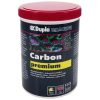
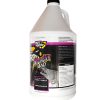
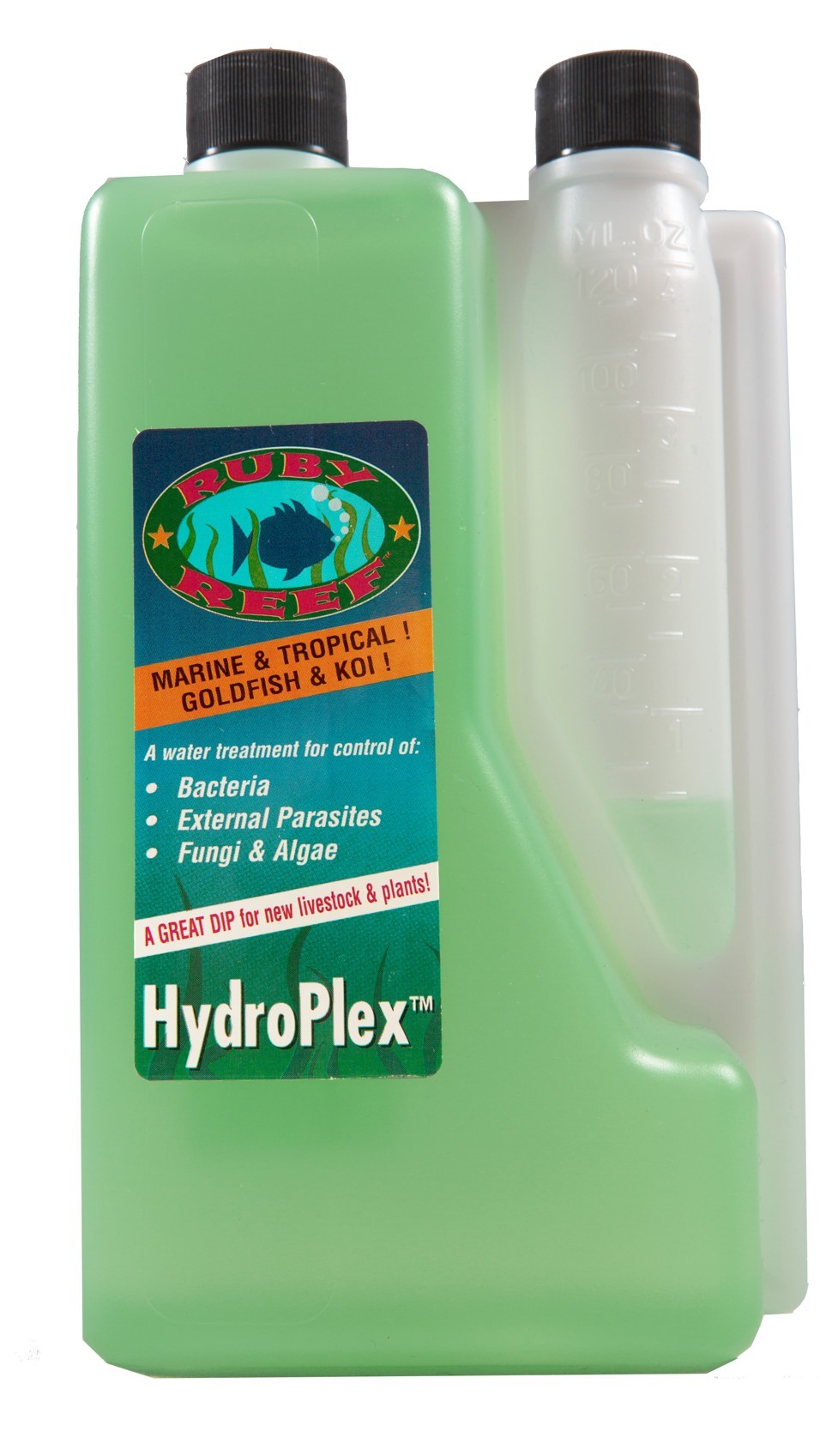
.jpg)

